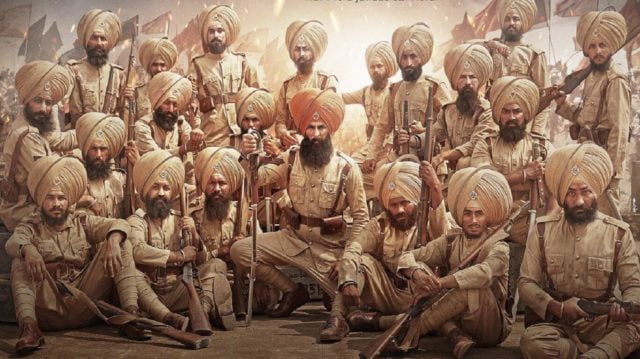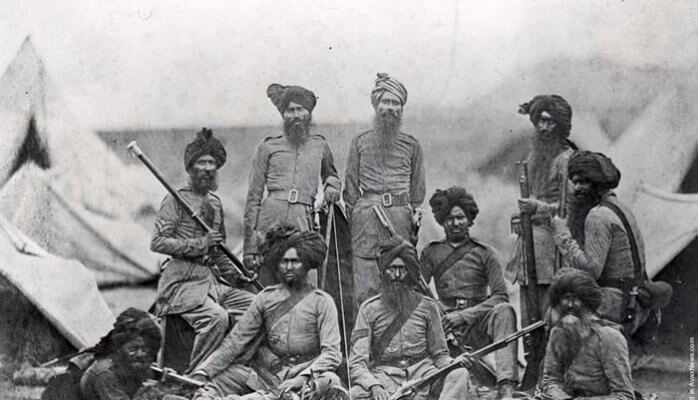The Battle of Saragarhi, fought on the 12th of September in 1897 remains iconic in the military circles till date due to the courage and selflessness shown by the soldiers posted there.
21 Sikh soldiers of the 36th Sikh Regiment for the British Indian Army were posted at the vital location of Saragarhi with their leader being Havildar Ishar Singh.
On the fated date, these soldiers were attacked around 9 am in the morning from all sides by more than 10,000 Afghan-Orakzai tribemen from the Afghanistan side.
Till today, this battle is considered to be one of the greated ‘last man standing’ acts in military history. But more than anything, the leader of the troop, Havildar Ishar Singh remains an iconic figure for his sheer bravery and leading his troops in a way that would protect Saragarhi.
However, what do we really know of this inspirational man?

Who Was Havildar Ishar Singh?
According to Capt Jay Singh-Sohal, a 34 year old third generation British Sikh who also made a film called ‘Saragarhi: The True Story’, Capt Jay Singh-Sohal, a 34 year old third generation British Sikh, Ishar Singh joined the Punjab Frontier Force around the age of 17 or 18.
While for the most part he chose to remain in the battlefield, he did return home, a village near Jagraon for a brief period of time, where he also got married.
Singh was drafted to the 36th Sikhs regiment about 10 years after it was raised in 1887 and as per British historian Maj Gen James Lunt, “Ishar Singh was a somewhat turbulent character whose independent nature had brought him more than once into conflict with his military superiors. Thus, Ishar Singh —in camp, a nuisance, in the field magnificent.”
While Saragarhi might seem like a modest post, it was its location that was the truly special, since it actually connected the 2 important forts of Lokhart and Gulistan, where all 3 posts communicated with each other using heliographic signal communication (essentially using sunlight to send Morse code).
That is why the Afghans initially decided to attack Saragarhi first in order to isolate the 2 forts which would then make it easier for the enemy to take all 3 posts down in one swoop.
But, it seems that the enemy was not aware of who Ishar Singh was, who by that time had already gained a good reputation of being a feisty and experienced sergeant.
Once the signaler Gurmukh Singh, who operated the heliographic machine reverted back to Ishar that they were ordered to ‘hold position’, the latter discussed with his men on whether to retreat or fight on.
It was only once everyone was in agreement and knew the consequences of their answer, that Havildar Singh had Gurmukh send back just one word as a reply, ‘Understood’.
The 21 Sikh used delaying tactics in order to give the other 2 forts enough time to prepare themselves for the attack, since it was only a matter of time before Saragarhi fell.

Read More: Do You Know The History Of Badluram Ka Badan, The Battle Song Of The Assam Regiment?
Even the Afghans were taken aback by these brave soldiers, and in an effort to bribe them said that if they surrendered and joined them, they would allow them to live and even give safe passage.
However, it is said that Havildar Singh refused to take this route and even during the last few hours, sent his men to the inner parts of the outpost’s building, so that they could stay safe, while he himself along with 2 other sepoys remained outside to face the tribesmen.
Ishar Singh and the sepoys were all greviously injured at this point, and even their ammunition had almost all run out. The 3 soldiers engaged in hand-to-hand combat with the enemy.
It seems that their sacrifice was not in vain, since their delaying the enemy and taking them on in such a head-on way allowed the other 2 forts to be better prepared and eventually defeat the enemy.
The heliograph that the 21 Sikhs were trying to protect also lead to the world finally learning of their courageous act, since the details of their valiant act were heliographed and then telegraphed back to London by a correspondent from Times, which was then reported by newspapers all over the world.
Another person who mentioned that Ishar Singh was more than just a soldier was the author of the book “Saragarhi and the Defence of the Samana Forts”, Captain Amarinder Singh who said that, “While he will always be remembered for his gallant conduct at Saragarhi, within the regiment they will also rue the loss of their best illicit liquor producer, and a man who borrowed meat on hoof for his men, when short of rations, from a neighbouring unit without asking them.”
This just goes to show that Ishar Singh was not just a simple soldier following the orders of his seniors, but a true leader who would go the extra mile just for the comfort and safety of his own troop.
Unfortunately it seems that Ishar Singh does not really have any living descendants, since as per the chairman of Saragarhi Foundation, Gurinderpal Singh Josan, his wife was killed by his brother who was then incarcerated at Andaman Nicobar Island at that time called Kaala Paani.
In such a case, movies like Kesari, that have popular names like Akshay Kumar and Parineeti Chopra and helmed by Dharma Productions are even more important to bring mass attention to these unsung heroes.

Surely we all can take inspiration from Havildar Ishar Singh who teaches us team-work, being a true leader, selflessness, bravery and more than anything not bending in the face of an enemy no matter the fate.
Image Credits: Google
Sources: History Extra, The Better India, Hindustan Times
Find the blogger @chirali_08
Other Recommendations:
The Battle Of Saragarhi, That Indians Have Forgotten But The British Celebrate: Demystifier
































Could you please tell me what the metal circles around the turbans in the movie Kesari?
Thank you in advance.
The Sikh warriors would wear weapons around their turbans, especially in context of the chakram, a round steel sharp-edged weapon that was worn around their turban, which is very helpful in saving heads and also to attack in hand to hand fight by hitting with head thus injuring enemy’s face area. Even two and three Chakrams were also worn of different sizes to be fixed on the turban
also watch “21 Sarfarosh” on netflix which is a much elaborate story of the battle and war tactics. In fact, i found it better than movie.. the battle scenes keeps you on edge
Very nice information on Havildar Ishar Singh. His character gives us a lesson about Bravery and how to be a true team leader. I appreciate your hard work in providing this information about this brave act of 21 Sikh soldiers. After reading this post every Indian will feel proud.
I am an American citizen living in the center of the U.S.A. I am 59 years old and I found these episodes by accident. I had to watch all 60+ episodes twice, once reading the subtitles, and the second time mostly watching the movie. I cried, yes I did. If I was Indian I would have felt immense pride, AND, AND, I feel like I got to see/feel a side of the spirituality to being Indian, hope that makes sense. I had a guy doing some work to our house in the spare bedroom. The last episode was playing. He came out and I was sitting on the couch, tears flowing. Wonderfully sad, heroic and band of Brothers movie. I’m sad there aren’t any more episodes to watch. :(
Army service without been in a war is like a drama of salvation, like of a religion. You will know a person is in the army or religion or none at the actual of the service.